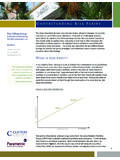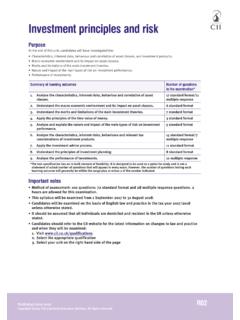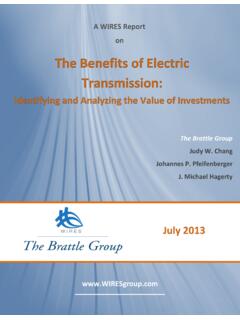Transcription of Pension Funds, Life-Cycle Asset Allocation and …
1 Pension Funds, Life-Cycle Asset Allocationand performance evaluation Fabio C. BaglianoCarolina FugazzaGiovanna NicodanoDipartimento di Scienze Economiche e Finanziarie G. Prato Universit di Torino Torino, andCeRP (Collegio Carlo Alberto)March 2009 AbstractWe present a Life-Cycle model forpension funds optimal Asset al-location, where the agents labor income process is calibrated to cap-ture a realistic hump-shaped pattern and the availablefinancial as-sets include one riskless and two risky assets, with returns potentiallycorrelated with labor income shocks. The sensitivity of the optimalallocation to the degree of investors risk aversion and the level of thereplacement ratio is explored. Also, the welfare costs associated withthe adoption of simple sub-optimal strategies ("age rule" and "1/Nrule") are computed, and new welfare-based metrics for Pension fundevaluation are disussed. This paper is part of a research project on "Optimal Asset Allocation For DefinedContribution Mandatory Pension Funds" sponsored by the World Bank and OECD.
2 Allthe simulations have been carried out using a MATLAB code written by C. thank, without implicating, Roy Amlan, Pablo Antolin, Zvi Bodie, Frank De Jong,Rudolph Heinz, Theo Nijman, and other participants at the OECD-WB Conference on" performance of Privately Managed Pension Funds" (Mexico City, January 2009). Ananonymous referee provided many useful comments on a previous draft of the IntroductionMethods for evaluating the performance of definedcontribution(DC)pensionfunds are similar to those applied to mutual funds, and typically associate ahigher return per unit of risk with better performance . These methods areadequate if a worker, or the Pension fund acting on her behalf, has preferencesdefined exclusively over the mean and the variance of portfolio , though, a worker contributes to a Pension fund in order to helpstabilize consumption during retirement years, given that the yearly pensiontransfer granted by typicalfirst-pillar schemes is lower than the last the optimal Asset Allocation ought to take into account, together withthe Asset return distributions and the risk aversion parameter that enter astandard portfolio choice problem, both any Pension transfer accruing afterretirement as well as the worker s life expectancy.
3 Since the Pension transferis usually a fraction of labor income earned during the last working year(which is, in turn, the outcome of the worker s risky professional history)the optimal Asset Allocation trades offthe gains from investing in high riskpremium assets with the needs to hedge labor income an explicit Life-Cycle perspective, this paper presents a simplemodel that is calibrated to deliver quantitative predictions on optimal port-folio Allocation for DC Pension funds. It then proposes a new, welfare-basedmetric in order to evaluate their performance . Our model belongs to theliterature on strategic Asset allocationfor long-term investors. The recentexpansion of defined-contribution Pension schemes, with respect to defined-benefit plans, and the ensuing focus on optimal investment policies, is oneof the motivations behind its growing importance. In this research areamodernfinance theory, as summarized for example by Campbell and Viceira(2002), has made substantial progress over the traditional (mean-variance,one-period) approach that still forms the basis for much practicalfinancialadvice.
4 Long investment horizons, the presence of risky labor income, and ofilliquid assets such as real estate, have been gradually incorporated into theanalysis of optimal portfolio choice. Moreover, the conditions under whichconventionalfinancial advice (such as the suggestion that investors shouldswitch from stock into bonds as they age, and that more risk-averse investorsshould hold a larger fraction of their risky portfolio in bonds than less risk-averse investors) is broadly consistent with optimal Asset Allocation policieshave been clarified. The key intuition is that optimal portfolios for long-terminvestors may not be the same as for short-term investors, because of a dif-1 The investor may also have more elaborate preferences that, combined with investmentopportunities, reduce to mean variance judgement of assets riskiness, and because of the crucial role playedby (nontradable) human wealth in the investors overall Asset more detail, our Life-Cycle model features two risky and one risklessassets, which are parameterized by thefirst two moments of their returndistribution, and correspond in our simulations to domestic stocks, bondsand bills.
5 As in Bodie, Merton and Samuelson (1992) and Cocco, Gomesand Maenhout (2005), early in the worker s life the average Asset allocationis tilted towards the high risk premium Asset , because labor income providesan effective hedge againstfinancial risks. On the contrary, in the two decadesbefore retirement, it gradually shifts to less risky bonds, because incomeprofiles peak at around age these patterns are associated to given values of the parametersthat describe both workers human capital and investment opportunities, aswell as the institutional framework, we perform sensitivity analysis alongseveral important dimensions. Thefirst examines the reaction of optimalasset Allocation to the labor income profile. For instance, a constructionworker may face a higher variance of uninsurable labor income shocks thana teacher (Campbell, Cocco, Gomes and Menhout 2001); alternatively, thecorrelation between stock returns and labor income may be higher for a self-employed or a manager than for a public sector employee.
6 If such differenceshave negligible effects on optimal Asset Allocation , the Pension plan may of-fer the same option to all partcipants. Instead, in our simulations optimalportfolio shares are highly heterogeneous across coeval agents (despite theircommon life expectancy, retirement age and replacement ratios) due to suchindividual-specific labor income shocks. Dispersion decreases as workers ap-proach retirement, the more so the higher is the labor income-stock returncorrelation: as this increases, the histories of labor incomes tend to convergeover time and so do the optimal associated portfolio choices. These resultssuggest that the optimal Allocation ought to be implemented through diver-sified investment options for most occupations and age Pension transfer in our model is afixed annuity (granted by an un-modelledfirst pillar or defined-benefitscheme)2and proportional to laborincome in the last working year.
7 Replacement ratios vary widely across coun-tries, as documented by OECD (2007), ranging from in UK to Greece. Such differences also depend on the inflation coverage of pensionannuities, which is often imperfect, implying a reduced average replacementratio. By measuring the sensitivity of optimal portfolio composition withrespect to the replacement ratio, we understand whether optimal pension2 Koijen, Nijman and Werker (2006) argue that it is suboptimal relative to alternativeannuity designs, despite its diffusion across Pension portfolio policies should vary across countries for given members the replacement ratio falls, simulations reveal that agents save moreduring their working life in anticipation of lower Pension incomes, thus accu-mulating a higher level offinancial wealth. This determines a lower optimalshare of stocks at all ages and for all values of the labor income-stock returncorrelation, holding risk aversion unchanged: with higherfinancial wealth,a given labor income becomes less apt to offset badfinancial outcomes.
8 Inother words, our model indicates that Asset Allocation in low replacementratio countries ought to be more conservative because workers contributionsto Pension funds ought to be the optimal Life-Cycle Asset Allocation allows to use it as aperformance evaluation benchmark, which explicitly accounts for pensionplan role in smooting participants consumption risk. We propose severalindicators to evaluate Pension funds performance . Thefirst metric takes theratio of the worker s ex-ante maximum welfare under optimal Asset allocationto her welfare under the Pension fund actual Asset Allocation : the higher theratio, the worse the Pension fund performance . Importantly, bad performancemay derive not only from a lower return per unit offinancial risk earned bythe Pension fund manager - which is what previous methods look at - but alsofrom a bad matching between the Pension fund portfolio and its members labor income and Pension costs of tailoring portfolios to age, labor income risk andother worker-specific characteristics can be quite high for Pension funds.
9 Thisis why we assess the welfare costs of implementing two simpler strategies,namely an age rule and a strstegy with portfolio sharesfixed at1/3foreach of our threefinancial assets, echoing the 1/Nrule of DeMiguel, Gar-lappi and Uppal (2008), that outperforms several portfolio strategies inexpostportfolio experiments. The latter strategy performs consistently betterthan the age rule , making it a better benchmark for evaluating the per-formance of Pension funds. Importantly, our numerical results suggest thatthis portfolio strategy is likely to be cost-efficient for both high wealth andhighly-risk-averse-average-wealth workers in medium-to-high replacement ra-tios countries. In these cases, the welfare costs of the suboptimal1/3ruleare often lower than 50 basis points per annum in terms of welfare-equivalentconsumption, which is likely to be lower than the management cost differ-ential. Thus,1/3may well become the benchmark Asset Allocation in present contribution is organized as follows.
10 The main theoreticalprinciples that may be relevant for Pension funds strategic Asset allocationare outlined in Section 2. Section 3 presents our simple operative life-cyclemodel, showing how it can be calibrated to deliver quantitative predictions on4optimal portfolio Allocation . The welfare metrics for Pension funds perfor-mance evaluation are introduced and discussed in Section 4. Afinal sectionsummarizes the main of the investment horizon andlabor income on portfolio choiceBasicfinancial theory provides simple Asset Allocation rules for an investormaximizing utility defined over expected (financial) wealth at the end of asingle-period horizon (EtWt+1) and no labor income, under specific assump-tions on the form of the utility function and on the distribution of assetreturns. In particular, when aconstantdegree ofrelative risk aversionisassumed (a simplifying assumption broadly consistent with some long-runfeatures of the economy, such as the stationary behaviour of interest ratesand risk premia in the face of long-run growth in consumption and wealth), investors have power utility, and returns are lognormally distributed, theinvestor trades offmean against variance in portfolio returns, obtaining (inthe case of one risky Asset ) the following optimal portfolio share: t=Etrt+1 rft+1+ 2t2 2twherert+1=log(1+Rt+1)andrft+1=log(1+Rf t+1)are the continuouslycompounded returns on the risky and riskless Asset respectively, 2tis theconditional variance of the risky return, and is the constant relative riskaversion parameter3.












